Organizational Change Management Report: Cultural Dimensions and Power
VerifiedAdded on 2021/04/24
|13
|3395
|104
Report
AI Summary
This report provides an overview of organizational change management, commencing with a comparative analysis of Singapore and Australia based on Hofstede's cultural dimensions, including power distance, individualism, masculinity, uncertainty avoidance, long-term orientation, and indulgence. It explores how national culture influences French and Raven's Five Bases of Power: legitimate, reward, expert, referent, and coercive. The report further argues the efficiency of power usage in change programs within the context of Singapore and Australia, considering the influence of cultural dimensions on organizational dynamics. It examines the impact of cultural factors on leadership and power dynamics in the context of organizational change, providing insights into how different cultural contexts affect the implementation and success of change initiatives. The report uses the Hofstede theory to compare the cultural dimensions between Singapore and Australia and then analyses how the national culture affects the five bases of power by French and Raven. Finally, the report provides arguments on the efficient use of power in change programs within organizations in Singapore and Australia.
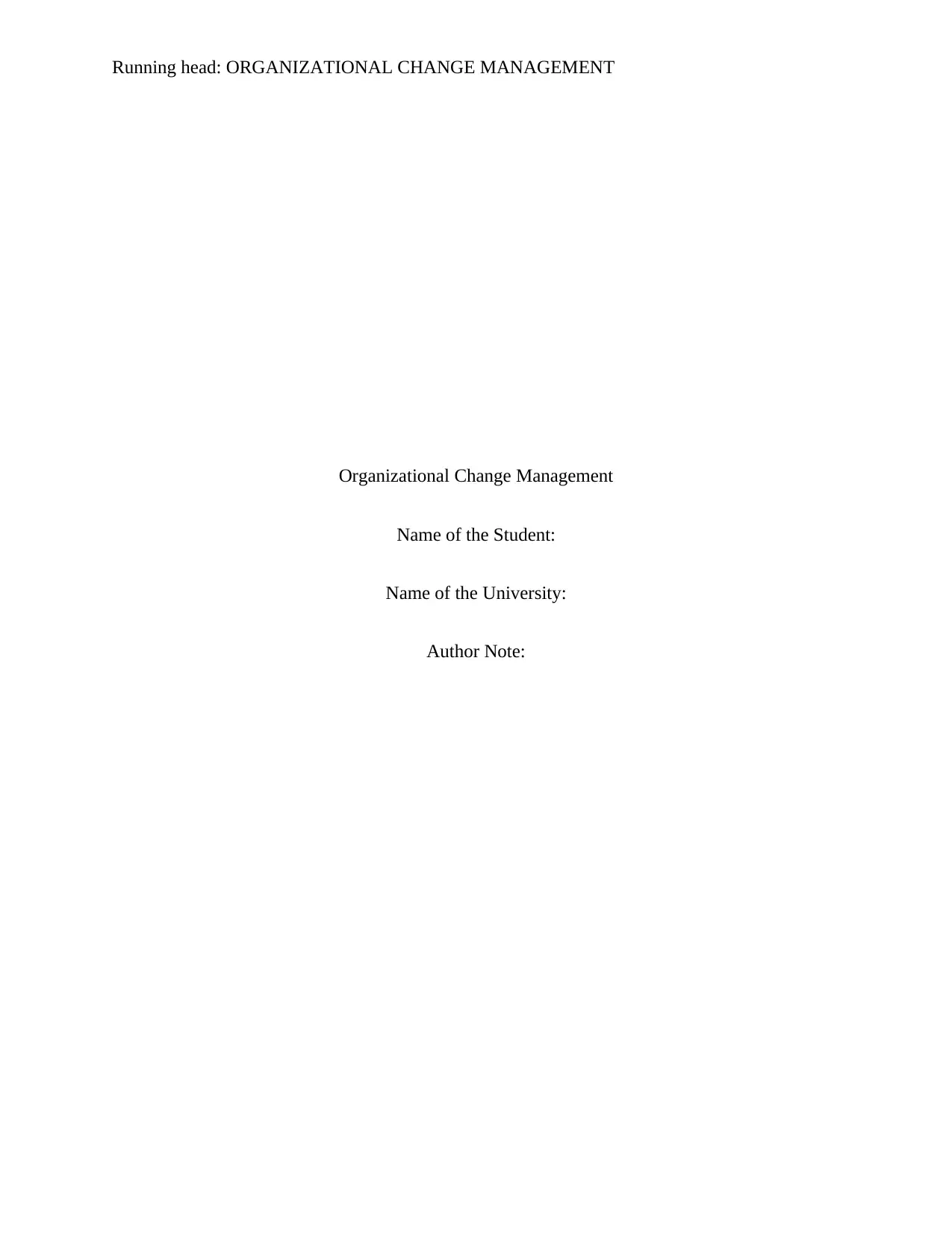
Running head: ORGANIZATIONAL CHANGE MANAGEMENT
Organizational Change Management
Name of the Student:
Name of the University:
Author Note:
Organizational Change Management
Name of the Student:
Name of the University:
Author Note:
Paraphrase This Document
Need a fresh take? Get an instant paraphrase of this document with our AI Paraphraser
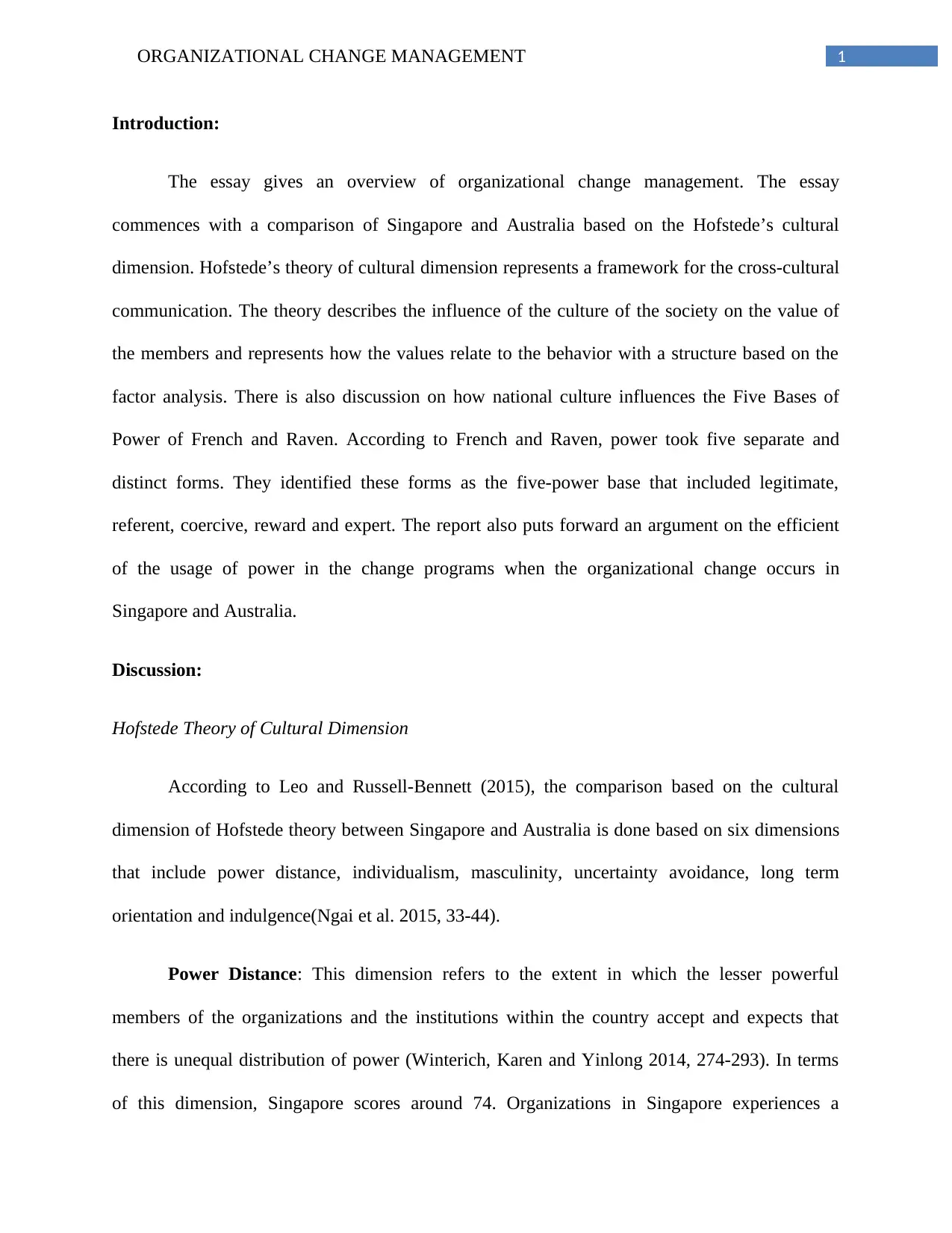
1ORGANIZATIONAL CHANGE MANAGEMENT
Introduction:
The essay gives an overview of organizational change management. The essay
commences with a comparison of Singapore and Australia based on the Hofstede’s cultural
dimension. Hofstede’s theory of cultural dimension represents a framework for the cross-cultural
communication. The theory describes the influence of the culture of the society on the value of
the members and represents how the values relate to the behavior with a structure based on the
factor analysis. There is also discussion on how national culture influences the Five Bases of
Power of French and Raven. According to French and Raven, power took five separate and
distinct forms. They identified these forms as the five-power base that included legitimate,
referent, coercive, reward and expert. The report also puts forward an argument on the efficient
of the usage of power in the change programs when the organizational change occurs in
Singapore and Australia.
Discussion:
Hofstede Theory of Cultural Dimension
According to Leo and Russell-Bennett (2015), the comparison based on the cultural
dimension of Hofstede theory between Singapore and Australia is done based on six dimensions
that include power distance, individualism, masculinity, uncertainty avoidance, long term
orientation and indulgence(Ngai et al. 2015, 33-44).
Power Distance: This dimension refers to the extent in which the lesser powerful
members of the organizations and the institutions within the country accept and expects that
there is unequal distribution of power (Winterich, Karen and Yinlong 2014, 274-293). In terms
of this dimension, Singapore scores around 74. Organizations in Singapore experiences a
Introduction:
The essay gives an overview of organizational change management. The essay
commences with a comparison of Singapore and Australia based on the Hofstede’s cultural
dimension. Hofstede’s theory of cultural dimension represents a framework for the cross-cultural
communication. The theory describes the influence of the culture of the society on the value of
the members and represents how the values relate to the behavior with a structure based on the
factor analysis. There is also discussion on how national culture influences the Five Bases of
Power of French and Raven. According to French and Raven, power took five separate and
distinct forms. They identified these forms as the five-power base that included legitimate,
referent, coercive, reward and expert. The report also puts forward an argument on the efficient
of the usage of power in the change programs when the organizational change occurs in
Singapore and Australia.
Discussion:
Hofstede Theory of Cultural Dimension
According to Leo and Russell-Bennett (2015), the comparison based on the cultural
dimension of Hofstede theory between Singapore and Australia is done based on six dimensions
that include power distance, individualism, masculinity, uncertainty avoidance, long term
orientation and indulgence(Ngai et al. 2015, 33-44).
Power Distance: This dimension refers to the extent in which the lesser powerful
members of the organizations and the institutions within the country accept and expects that
there is unequal distribution of power (Winterich, Karen and Yinlong 2014, 274-293). In terms
of this dimension, Singapore scores around 74. Organizations in Singapore experiences a
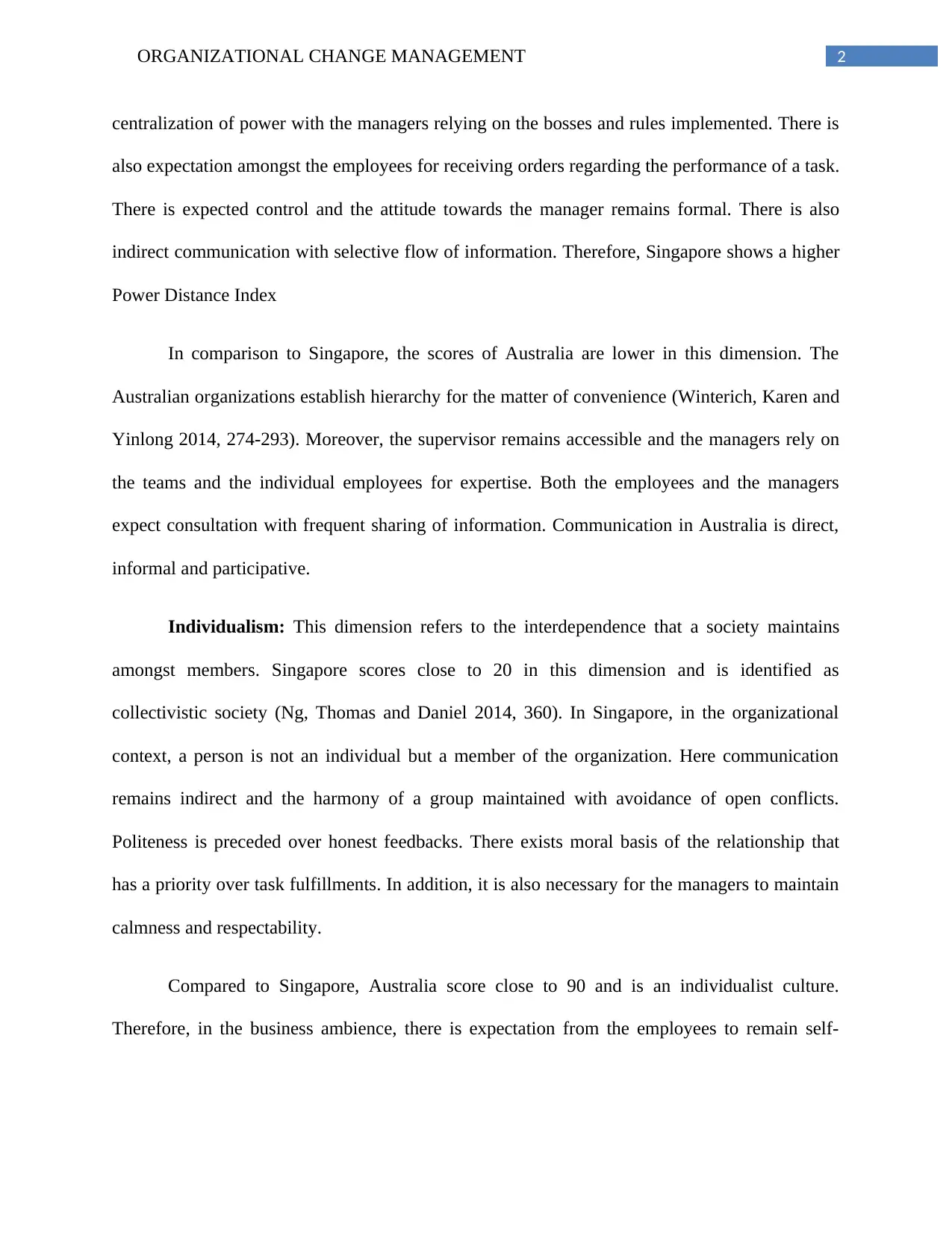
2ORGANIZATIONAL CHANGE MANAGEMENT
centralization of power with the managers relying on the bosses and rules implemented. There is
also expectation amongst the employees for receiving orders regarding the performance of a task.
There is expected control and the attitude towards the manager remains formal. There is also
indirect communication with selective flow of information. Therefore, Singapore shows a higher
Power Distance Index
In comparison to Singapore, the scores of Australia are lower in this dimension. The
Australian organizations establish hierarchy for the matter of convenience (Winterich, Karen and
Yinlong 2014, 274-293). Moreover, the supervisor remains accessible and the managers rely on
the teams and the individual employees for expertise. Both the employees and the managers
expect consultation with frequent sharing of information. Communication in Australia is direct,
informal and participative.
Individualism: This dimension refers to the interdependence that a society maintains
amongst members. Singapore scores close to 20 in this dimension and is identified as
collectivistic society (Ng, Thomas and Daniel 2014, 360). In Singapore, in the organizational
context, a person is not an individual but a member of the organization. Here communication
remains indirect and the harmony of a group maintained with avoidance of open conflicts.
Politeness is preceded over honest feedbacks. There exists moral basis of the relationship that
has a priority over task fulfillments. In addition, it is also necessary for the managers to maintain
calmness and respectability.
Compared to Singapore, Australia score close to 90 and is an individualist culture.
Therefore, in the business ambience, there is expectation from the employees to remain self-
centralization of power with the managers relying on the bosses and rules implemented. There is
also expectation amongst the employees for receiving orders regarding the performance of a task.
There is expected control and the attitude towards the manager remains formal. There is also
indirect communication with selective flow of information. Therefore, Singapore shows a higher
Power Distance Index
In comparison to Singapore, the scores of Australia are lower in this dimension. The
Australian organizations establish hierarchy for the matter of convenience (Winterich, Karen and
Yinlong 2014, 274-293). Moreover, the supervisor remains accessible and the managers rely on
the teams and the individual employees for expertise. Both the employees and the managers
expect consultation with frequent sharing of information. Communication in Australia is direct,
informal and participative.
Individualism: This dimension refers to the interdependence that a society maintains
amongst members. Singapore scores close to 20 in this dimension and is identified as
collectivistic society (Ng, Thomas and Daniel 2014, 360). In Singapore, in the organizational
context, a person is not an individual but a member of the organization. Here communication
remains indirect and the harmony of a group maintained with avoidance of open conflicts.
Politeness is preceded over honest feedbacks. There exists moral basis of the relationship that
has a priority over task fulfillments. In addition, it is also necessary for the managers to maintain
calmness and respectability.
Compared to Singapore, Australia score close to 90 and is an individualist culture.
Therefore, in the business ambience, there is expectation from the employees to remain self-
⊘ This is a preview!⊘
Do you want full access?
Subscribe today to unlock all pages.

Trusted by 1+ million students worldwide
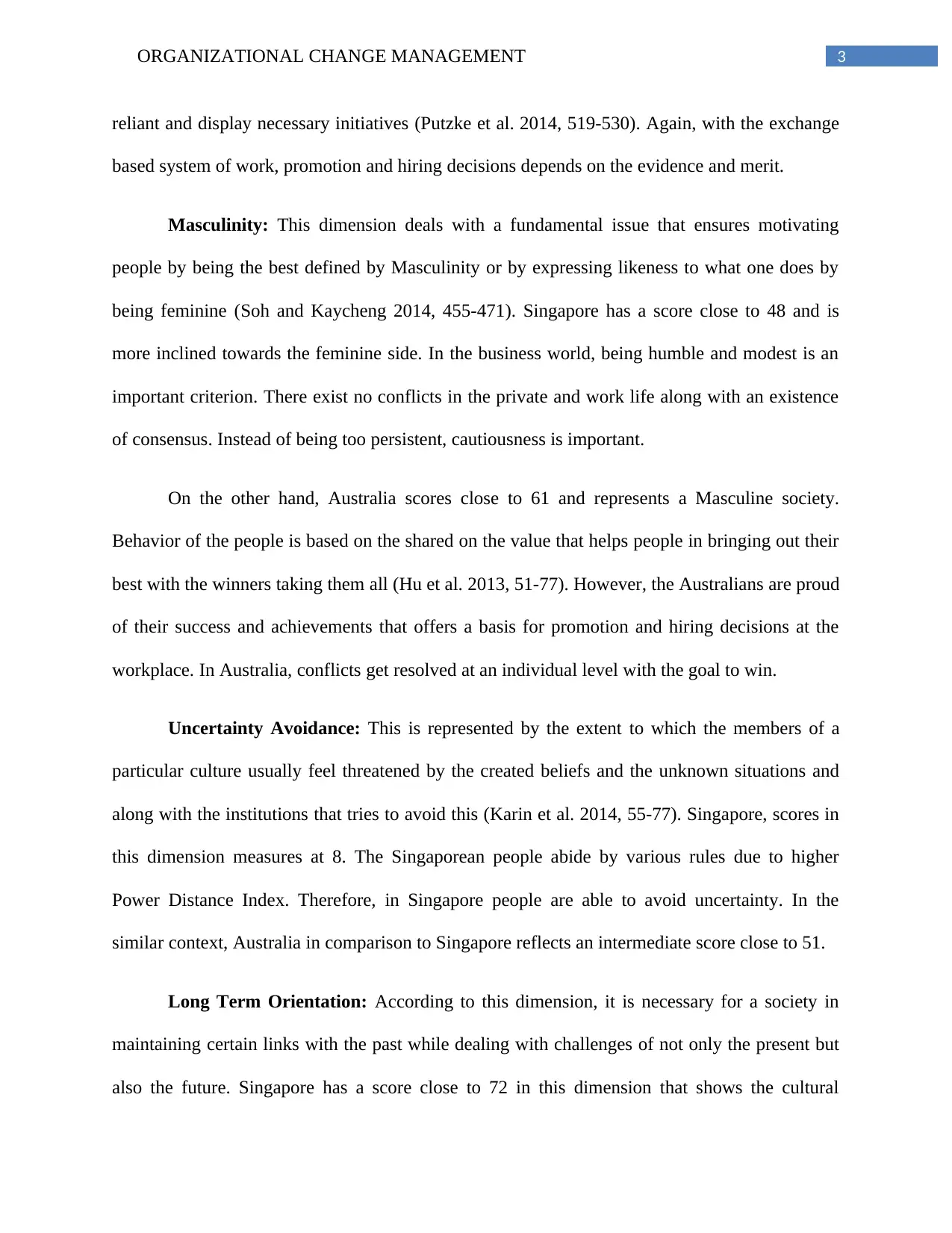
3ORGANIZATIONAL CHANGE MANAGEMENT
reliant and display necessary initiatives (Putzke et al. 2014, 519-530). Again, with the exchange
based system of work, promotion and hiring decisions depends on the evidence and merit.
Masculinity: This dimension deals with a fundamental issue that ensures motivating
people by being the best defined by Masculinity or by expressing likeness to what one does by
being feminine (Soh and Kaycheng 2014, 455-471). Singapore has a score close to 48 and is
more inclined towards the feminine side. In the business world, being humble and modest is an
important criterion. There exist no conflicts in the private and work life along with an existence
of consensus. Instead of being too persistent, cautiousness is important.
On the other hand, Australia scores close to 61 and represents a Masculine society.
Behavior of the people is based on the shared on the value that helps people in bringing out their
best with the winners taking them all (Hu et al. 2013, 51-77). However, the Australians are proud
of their success and achievements that offers a basis for promotion and hiring decisions at the
workplace. In Australia, conflicts get resolved at an individual level with the goal to win.
Uncertainty Avoidance: This is represented by the extent to which the members of a
particular culture usually feel threatened by the created beliefs and the unknown situations and
along with the institutions that tries to avoid this (Karin et al. 2014, 55-77). Singapore, scores in
this dimension measures at 8. The Singaporean people abide by various rules due to higher
Power Distance Index. Therefore, in Singapore people are able to avoid uncertainty. In the
similar context, Australia in comparison to Singapore reflects an intermediate score close to 51.
Long Term Orientation: According to this dimension, it is necessary for a society in
maintaining certain links with the past while dealing with challenges of not only the present but
also the future. Singapore has a score close to 72 in this dimension that shows the cultural
reliant and display necessary initiatives (Putzke et al. 2014, 519-530). Again, with the exchange
based system of work, promotion and hiring decisions depends on the evidence and merit.
Masculinity: This dimension deals with a fundamental issue that ensures motivating
people by being the best defined by Masculinity or by expressing likeness to what one does by
being feminine (Soh and Kaycheng 2014, 455-471). Singapore has a score close to 48 and is
more inclined towards the feminine side. In the business world, being humble and modest is an
important criterion. There exist no conflicts in the private and work life along with an existence
of consensus. Instead of being too persistent, cautiousness is important.
On the other hand, Australia scores close to 61 and represents a Masculine society.
Behavior of the people is based on the shared on the value that helps people in bringing out their
best with the winners taking them all (Hu et al. 2013, 51-77). However, the Australians are proud
of their success and achievements that offers a basis for promotion and hiring decisions at the
workplace. In Australia, conflicts get resolved at an individual level with the goal to win.
Uncertainty Avoidance: This is represented by the extent to which the members of a
particular culture usually feel threatened by the created beliefs and the unknown situations and
along with the institutions that tries to avoid this (Karin et al. 2014, 55-77). Singapore, scores in
this dimension measures at 8. The Singaporean people abide by various rules due to higher
Power Distance Index. Therefore, in Singapore people are able to avoid uncertainty. In the
similar context, Australia in comparison to Singapore reflects an intermediate score close to 51.
Long Term Orientation: According to this dimension, it is necessary for a society in
maintaining certain links with the past while dealing with challenges of not only the present but
also the future. Singapore has a score close to 72 in this dimension that shows the cultural
Paraphrase This Document
Need a fresh take? Get an instant paraphrase of this document with our AI Paraphraser
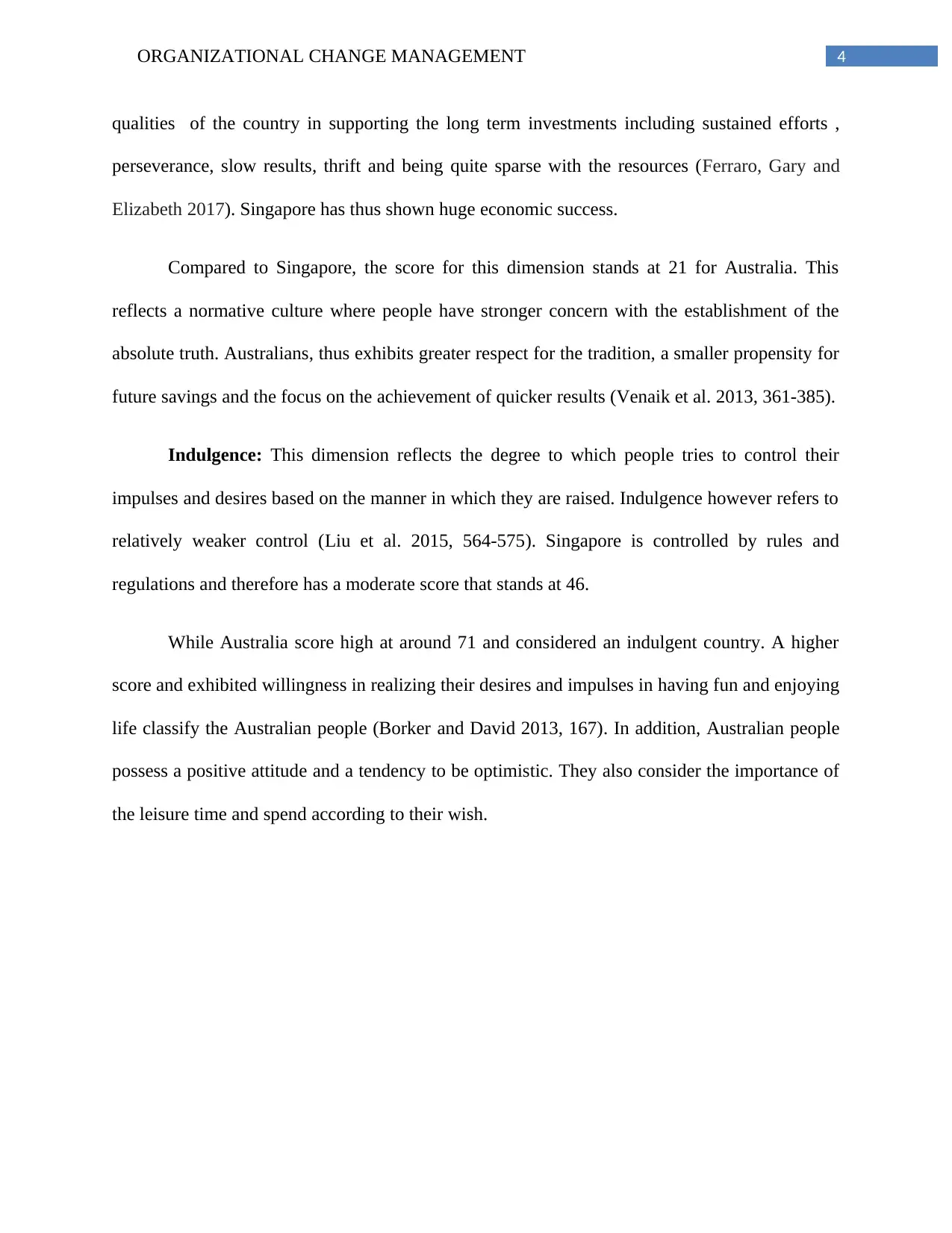
4ORGANIZATIONAL CHANGE MANAGEMENT
qualities of the country in supporting the long term investments including sustained efforts ,
perseverance, slow results, thrift and being quite sparse with the resources (Ferraro, Gary and
Elizabeth 2017). Singapore has thus shown huge economic success.
Compared to Singapore, the score for this dimension stands at 21 for Australia. This
reflects a normative culture where people have stronger concern with the establishment of the
absolute truth. Australians, thus exhibits greater respect for the tradition, a smaller propensity for
future savings and the focus on the achievement of quicker results (Venaik et al. 2013, 361-385).
Indulgence: This dimension reflects the degree to which people tries to control their
impulses and desires based on the manner in which they are raised. Indulgence however refers to
relatively weaker control (Liu et al. 2015, 564-575). Singapore is controlled by rules and
regulations and therefore has a moderate score that stands at 46.
While Australia score high at around 71 and considered an indulgent country. A higher
score and exhibited willingness in realizing their desires and impulses in having fun and enjoying
life classify the Australian people (Borker and David 2013, 167). In addition, Australian people
possess a positive attitude and a tendency to be optimistic. They also consider the importance of
the leisure time and spend according to their wish.
qualities of the country in supporting the long term investments including sustained efforts ,
perseverance, slow results, thrift and being quite sparse with the resources (Ferraro, Gary and
Elizabeth 2017). Singapore has thus shown huge economic success.
Compared to Singapore, the score for this dimension stands at 21 for Australia. This
reflects a normative culture where people have stronger concern with the establishment of the
absolute truth. Australians, thus exhibits greater respect for the tradition, a smaller propensity for
future savings and the focus on the achievement of quicker results (Venaik et al. 2013, 361-385).
Indulgence: This dimension reflects the degree to which people tries to control their
impulses and desires based on the manner in which they are raised. Indulgence however refers to
relatively weaker control (Liu et al. 2015, 564-575). Singapore is controlled by rules and
regulations and therefore has a moderate score that stands at 46.
While Australia score high at around 71 and considered an indulgent country. A higher
score and exhibited willingness in realizing their desires and impulses in having fun and enjoying
life classify the Australian people (Borker and David 2013, 167). In addition, Australian people
possess a positive attitude and a tendency to be optimistic. They also consider the importance of
the leisure time and spend according to their wish.
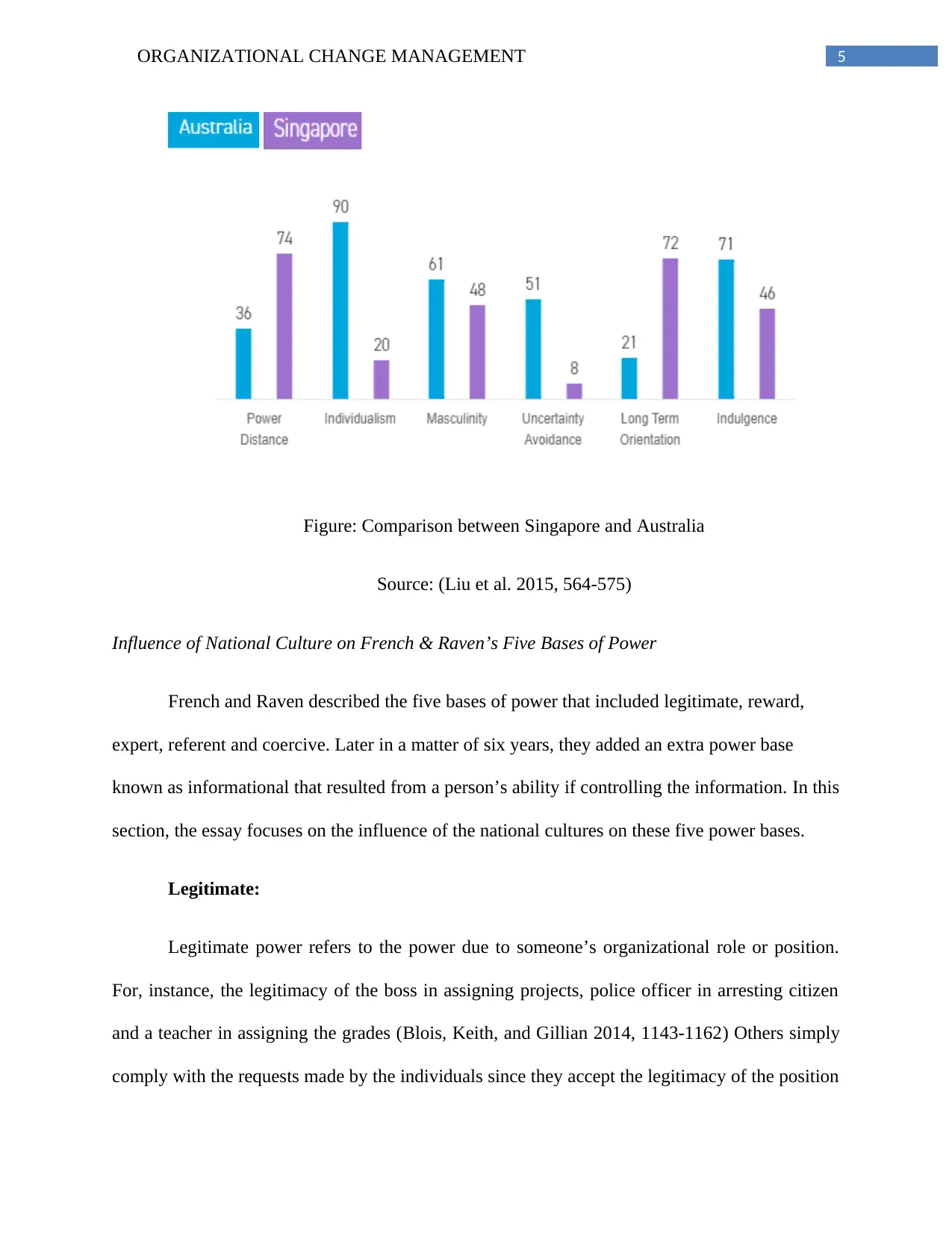
5ORGANIZATIONAL CHANGE MANAGEMENT
Figure: Comparison between Singapore and Australia
Source: (Liu et al. 2015, 564-575)
Influence of National Culture on French & Raven’s Five Bases of Power
French and Raven described the five bases of power that included legitimate, reward,
expert, referent and coercive. Later in a matter of six years, they added an extra power base
known as informational that resulted from a person’s ability if controlling the information. In this
section, the essay focuses on the influence of the national cultures on these five power bases.
Legitimate:
Legitimate power refers to the power due to someone’s organizational role or position.
For, instance, the legitimacy of the boss in assigning projects, police officer in arresting citizen
and a teacher in assigning the grades (Blois, Keith, and Gillian 2014, 1143-1162) Others simply
comply with the requests made by the individuals since they accept the legitimacy of the position
Figure: Comparison between Singapore and Australia
Source: (Liu et al. 2015, 564-575)
Influence of National Culture on French & Raven’s Five Bases of Power
French and Raven described the five bases of power that included legitimate, reward,
expert, referent and coercive. Later in a matter of six years, they added an extra power base
known as informational that resulted from a person’s ability if controlling the information. In this
section, the essay focuses on the influence of the national cultures on these five power bases.
Legitimate:
Legitimate power refers to the power due to someone’s organizational role or position.
For, instance, the legitimacy of the boss in assigning projects, police officer in arresting citizen
and a teacher in assigning the grades (Blois, Keith, and Gillian 2014, 1143-1162) Others simply
comply with the requests made by the individuals since they accept the legitimacy of the position
⊘ This is a preview!⊘
Do you want full access?
Subscribe today to unlock all pages.

Trusted by 1+ million students worldwide
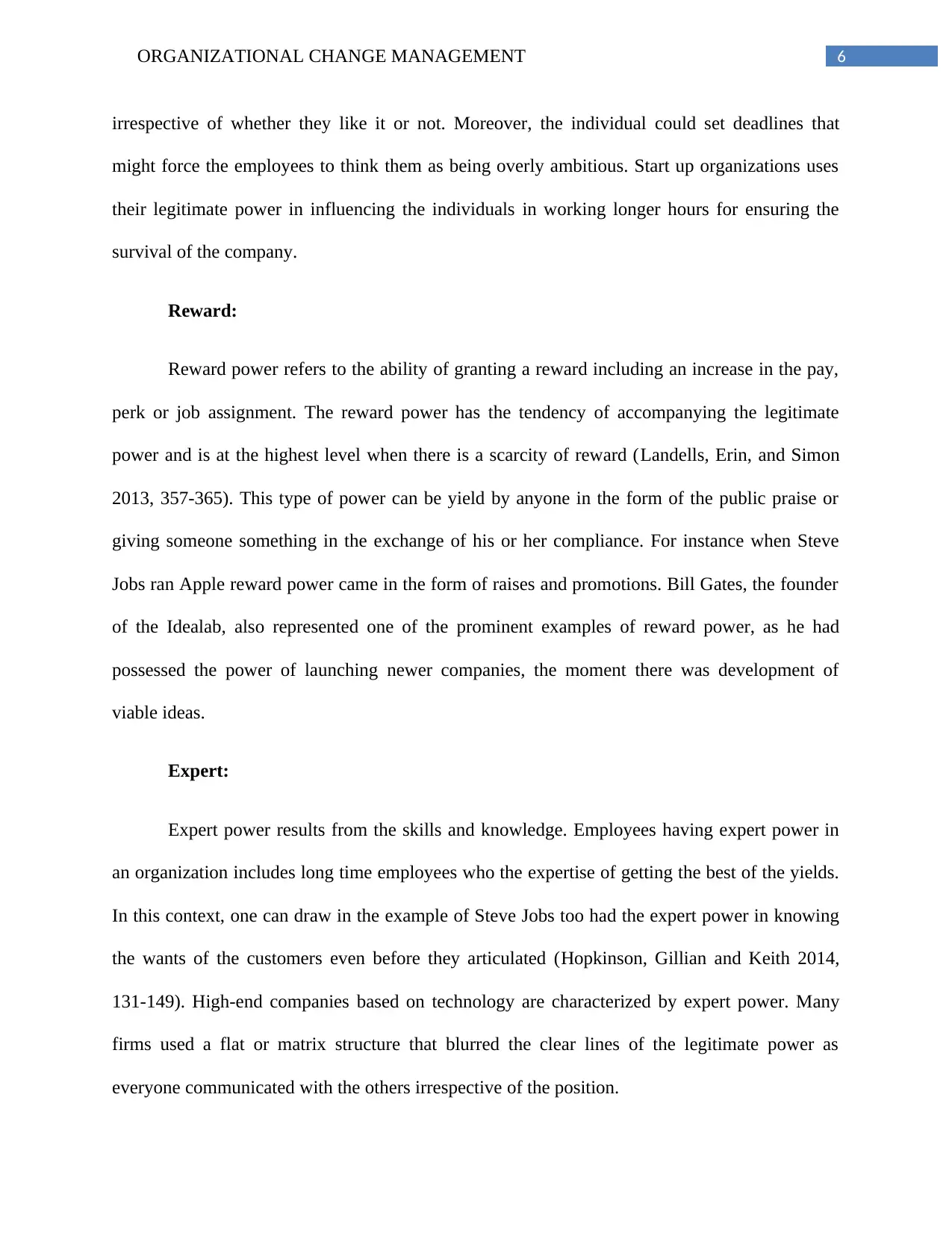
6ORGANIZATIONAL CHANGE MANAGEMENT
irrespective of whether they like it or not. Moreover, the individual could set deadlines that
might force the employees to think them as being overly ambitious. Start up organizations uses
their legitimate power in influencing the individuals in working longer hours for ensuring the
survival of the company.
Reward:
Reward power refers to the ability of granting a reward including an increase in the pay,
perk or job assignment. The reward power has the tendency of accompanying the legitimate
power and is at the highest level when there is a scarcity of reward (Landells, Erin, and Simon
2013, 357-365). This type of power can be yield by anyone in the form of the public praise or
giving someone something in the exchange of his or her compliance. For instance when Steve
Jobs ran Apple reward power came in the form of raises and promotions. Bill Gates, the founder
of the Idealab, also represented one of the prominent examples of reward power, as he had
possessed the power of launching newer companies, the moment there was development of
viable ideas.
Expert:
Expert power results from the skills and knowledge. Employees having expert power in
an organization includes long time employees who the expertise of getting the best of the yields.
In this context, one can draw in the example of Steve Jobs too had the expert power in knowing
the wants of the customers even before they articulated (Hopkinson, Gillian and Keith 2014,
131-149). High-end companies based on technology are characterized by expert power. Many
firms used a flat or matrix structure that blurred the clear lines of the legitimate power as
everyone communicated with the others irrespective of the position.
irrespective of whether they like it or not. Moreover, the individual could set deadlines that
might force the employees to think them as being overly ambitious. Start up organizations uses
their legitimate power in influencing the individuals in working longer hours for ensuring the
survival of the company.
Reward:
Reward power refers to the ability of granting a reward including an increase in the pay,
perk or job assignment. The reward power has the tendency of accompanying the legitimate
power and is at the highest level when there is a scarcity of reward (Landells, Erin, and Simon
2013, 357-365). This type of power can be yield by anyone in the form of the public praise or
giving someone something in the exchange of his or her compliance. For instance when Steve
Jobs ran Apple reward power came in the form of raises and promotions. Bill Gates, the founder
of the Idealab, also represented one of the prominent examples of reward power, as he had
possessed the power of launching newer companies, the moment there was development of
viable ideas.
Expert:
Expert power results from the skills and knowledge. Employees having expert power in
an organization includes long time employees who the expertise of getting the best of the yields.
In this context, one can draw in the example of Steve Jobs too had the expert power in knowing
the wants of the customers even before they articulated (Hopkinson, Gillian and Keith 2014,
131-149). High-end companies based on technology are characterized by expert power. Many
firms used a flat or matrix structure that blurred the clear lines of the legitimate power as
everyone communicated with the others irrespective of the position.
Paraphrase This Document
Need a fresh take? Get an instant paraphrase of this document with our AI Paraphraser
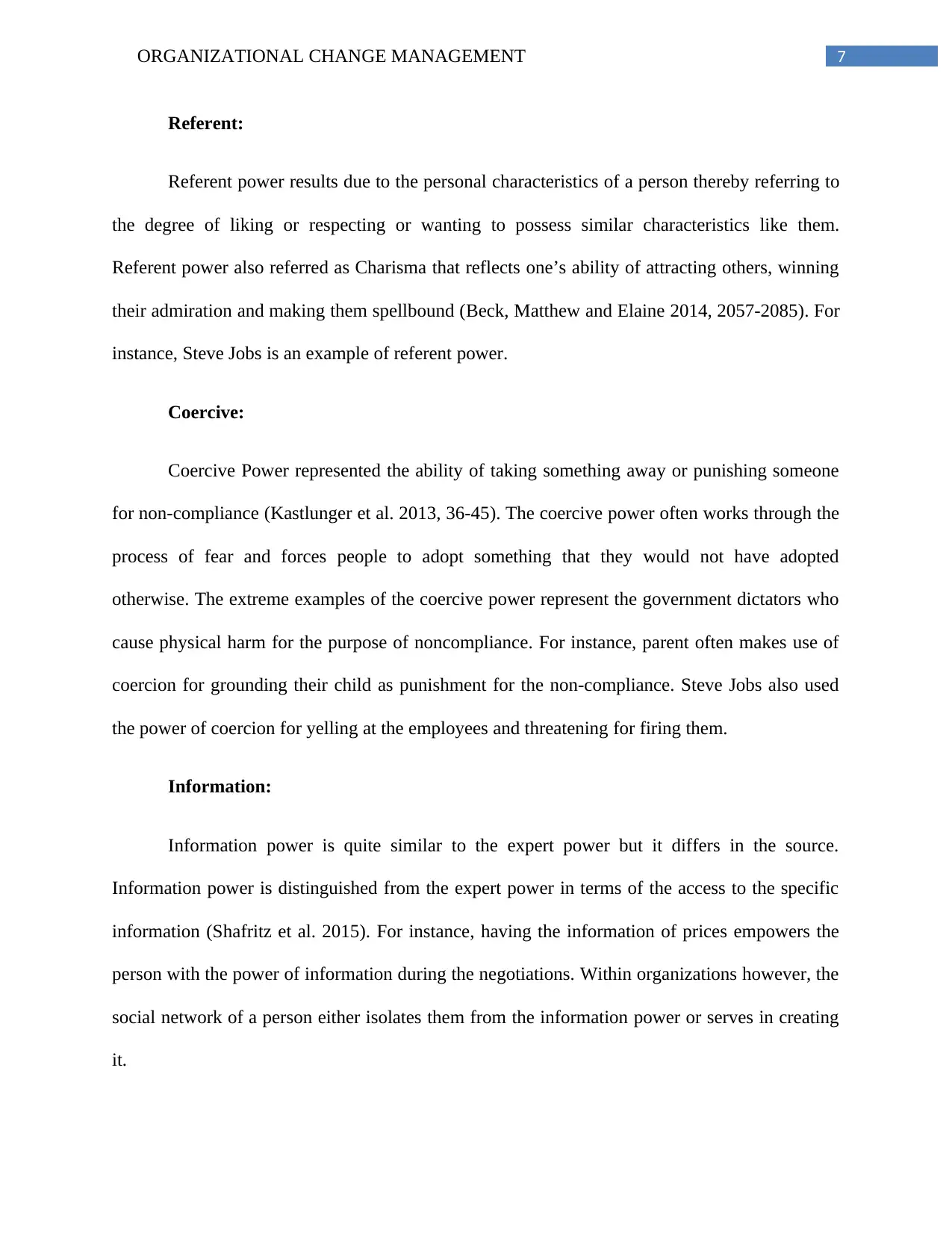
7ORGANIZATIONAL CHANGE MANAGEMENT
Referent:
Referent power results due to the personal characteristics of a person thereby referring to
the degree of liking or respecting or wanting to possess similar characteristics like them.
Referent power also referred as Charisma that reflects one’s ability of attracting others, winning
their admiration and making them spellbound (Beck, Matthew and Elaine 2014, 2057-2085). For
instance, Steve Jobs is an example of referent power.
Coercive:
Coercive Power represented the ability of taking something away or punishing someone
for non-compliance (Kastlunger et al. 2013, 36-45). The coercive power often works through the
process of fear and forces people to adopt something that they would not have adopted
otherwise. The extreme examples of the coercive power represent the government dictators who
cause physical harm for the purpose of noncompliance. For instance, parent often makes use of
coercion for grounding their child as punishment for the non-compliance. Steve Jobs also used
the power of coercion for yelling at the employees and threatening for firing them.
Information:
Information power is quite similar to the expert power but it differs in the source.
Information power is distinguished from the expert power in terms of the access to the specific
information (Shafritz et al. 2015). For instance, having the information of prices empowers the
person with the power of information during the negotiations. Within organizations however, the
social network of a person either isolates them from the information power or serves in creating
it.
Referent:
Referent power results due to the personal characteristics of a person thereby referring to
the degree of liking or respecting or wanting to possess similar characteristics like them.
Referent power also referred as Charisma that reflects one’s ability of attracting others, winning
their admiration and making them spellbound (Beck, Matthew and Elaine 2014, 2057-2085). For
instance, Steve Jobs is an example of referent power.
Coercive:
Coercive Power represented the ability of taking something away or punishing someone
for non-compliance (Kastlunger et al. 2013, 36-45). The coercive power often works through the
process of fear and forces people to adopt something that they would not have adopted
otherwise. The extreme examples of the coercive power represent the government dictators who
cause physical harm for the purpose of noncompliance. For instance, parent often makes use of
coercion for grounding their child as punishment for the non-compliance. Steve Jobs also used
the power of coercion for yelling at the employees and threatening for firing them.
Information:
Information power is quite similar to the expert power but it differs in the source.
Information power is distinguished from the expert power in terms of the access to the specific
information (Shafritz et al. 2015). For instance, having the information of prices empowers the
person with the power of information during the negotiations. Within organizations however, the
social network of a person either isolates them from the information power or serves in creating
it.
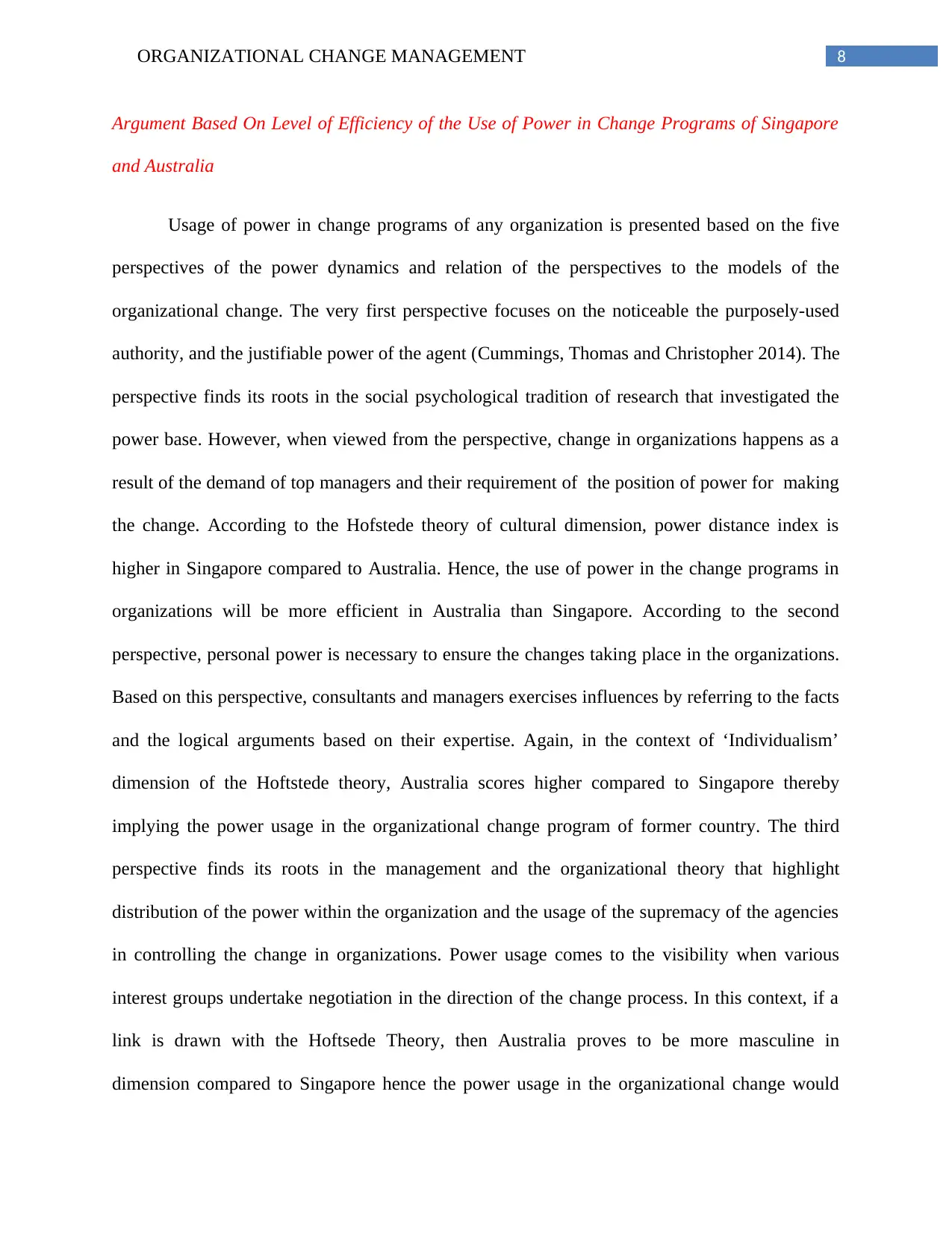
8ORGANIZATIONAL CHANGE MANAGEMENT
Argument Based On Level of Efficiency of the Use of Power in Change Programs of Singapore
and Australia
Usage of power in change programs of any organization is presented based on the five
perspectives of the power dynamics and relation of the perspectives to the models of the
organizational change. The very first perspective focuses on the noticeable the purposely-used
authority, and the justifiable power of the agent (Cummings, Thomas and Christopher 2014). The
perspective finds its roots in the social psychological tradition of research that investigated the
power base. However, when viewed from the perspective, change in organizations happens as a
result of the demand of top managers and their requirement of the position of power for making
the change. According to the Hofstede theory of cultural dimension, power distance index is
higher in Singapore compared to Australia. Hence, the use of power in the change programs in
organizations will be more efficient in Australia than Singapore. According to the second
perspective, personal power is necessary to ensure the changes taking place in the organizations.
Based on this perspective, consultants and managers exercises influences by referring to the facts
and the logical arguments based on their expertise. Again, in the context of ‘Individualism’
dimension of the Hoftstede theory, Australia scores higher compared to Singapore thereby
implying the power usage in the organizational change program of former country. The third
perspective finds its roots in the management and the organizational theory that highlight
distribution of the power within the organization and the usage of the supremacy of the agencies
in controlling the change in organizations. Power usage comes to the visibility when various
interest groups undertake negotiation in the direction of the change process. In this context, if a
link is drawn with the Hoftsede Theory, then Australia proves to be more masculine in
dimension compared to Singapore hence the power usage in the organizational change would
Argument Based On Level of Efficiency of the Use of Power in Change Programs of Singapore
and Australia
Usage of power in change programs of any organization is presented based on the five
perspectives of the power dynamics and relation of the perspectives to the models of the
organizational change. The very first perspective focuses on the noticeable the purposely-used
authority, and the justifiable power of the agent (Cummings, Thomas and Christopher 2014). The
perspective finds its roots in the social psychological tradition of research that investigated the
power base. However, when viewed from the perspective, change in organizations happens as a
result of the demand of top managers and their requirement of the position of power for making
the change. According to the Hofstede theory of cultural dimension, power distance index is
higher in Singapore compared to Australia. Hence, the use of power in the change programs in
organizations will be more efficient in Australia than Singapore. According to the second
perspective, personal power is necessary to ensure the changes taking place in the organizations.
Based on this perspective, consultants and managers exercises influences by referring to the facts
and the logical arguments based on their expertise. Again, in the context of ‘Individualism’
dimension of the Hoftstede theory, Australia scores higher compared to Singapore thereby
implying the power usage in the organizational change program of former country. The third
perspective finds its roots in the management and the organizational theory that highlight
distribution of the power within the organization and the usage of the supremacy of the agencies
in controlling the change in organizations. Power usage comes to the visibility when various
interest groups undertake negotiation in the direction of the change process. In this context, if a
link is drawn with the Hoftsede Theory, then Australia proves to be more masculine in
dimension compared to Singapore hence the power usage in the organizational change would
⊘ This is a preview!⊘
Do you want full access?
Subscribe today to unlock all pages.

Trusted by 1+ million students worldwide
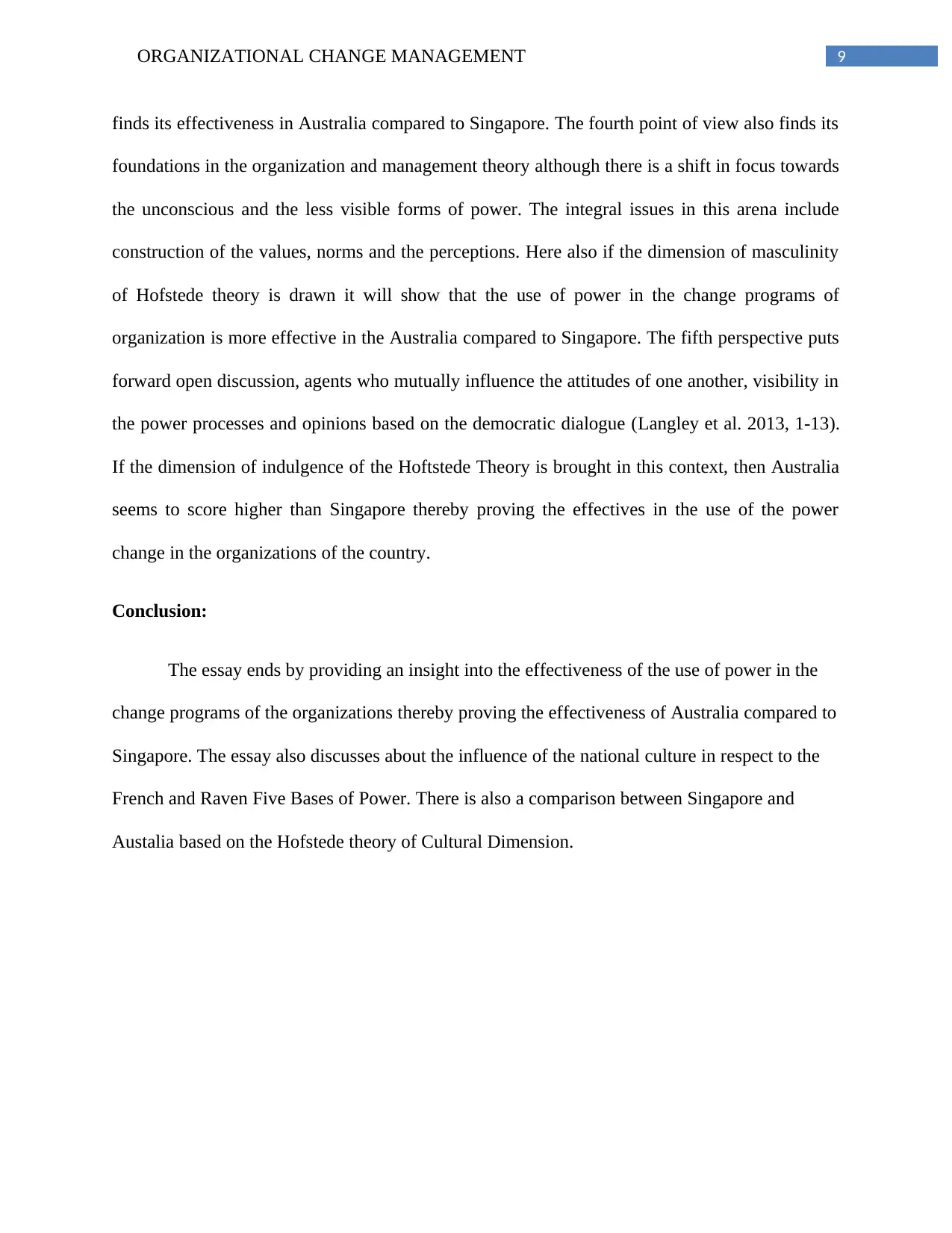
9ORGANIZATIONAL CHANGE MANAGEMENT
finds its effectiveness in Australia compared to Singapore. The fourth point of view also finds its
foundations in the organization and management theory although there is a shift in focus towards
the unconscious and the less visible forms of power. The integral issues in this arena include
construction of the values, norms and the perceptions. Here also if the dimension of masculinity
of Hofstede theory is drawn it will show that the use of power in the change programs of
organization is more effective in the Australia compared to Singapore. The fifth perspective puts
forward open discussion, agents who mutually influence the attitudes of one another, visibility in
the power processes and opinions based on the democratic dialogue (Langley et al. 2013, 1-13).
If the dimension of indulgence of the Hoftstede Theory is brought in this context, then Australia
seems to score higher than Singapore thereby proving the effectives in the use of the power
change in the organizations of the country.
Conclusion:
The essay ends by providing an insight into the effectiveness of the use of power in the
change programs of the organizations thereby proving the effectiveness of Australia compared to
Singapore. The essay also discusses about the influence of the national culture in respect to the
French and Raven Five Bases of Power. There is also a comparison between Singapore and
Austalia based on the Hofstede theory of Cultural Dimension.
finds its effectiveness in Australia compared to Singapore. The fourth point of view also finds its
foundations in the organization and management theory although there is a shift in focus towards
the unconscious and the less visible forms of power. The integral issues in this arena include
construction of the values, norms and the perceptions. Here also if the dimension of masculinity
of Hofstede theory is drawn it will show that the use of power in the change programs of
organization is more effective in the Australia compared to Singapore. The fifth perspective puts
forward open discussion, agents who mutually influence the attitudes of one another, visibility in
the power processes and opinions based on the democratic dialogue (Langley et al. 2013, 1-13).
If the dimension of indulgence of the Hoftstede Theory is brought in this context, then Australia
seems to score higher than Singapore thereby proving the effectives in the use of the power
change in the organizations of the country.
Conclusion:
The essay ends by providing an insight into the effectiveness of the use of power in the
change programs of the organizations thereby proving the effectiveness of Australia compared to
Singapore. The essay also discusses about the influence of the national culture in respect to the
French and Raven Five Bases of Power. There is also a comparison between Singapore and
Austalia based on the Hofstede theory of Cultural Dimension.
Paraphrase This Document
Need a fresh take? Get an instant paraphrase of this document with our AI Paraphraser
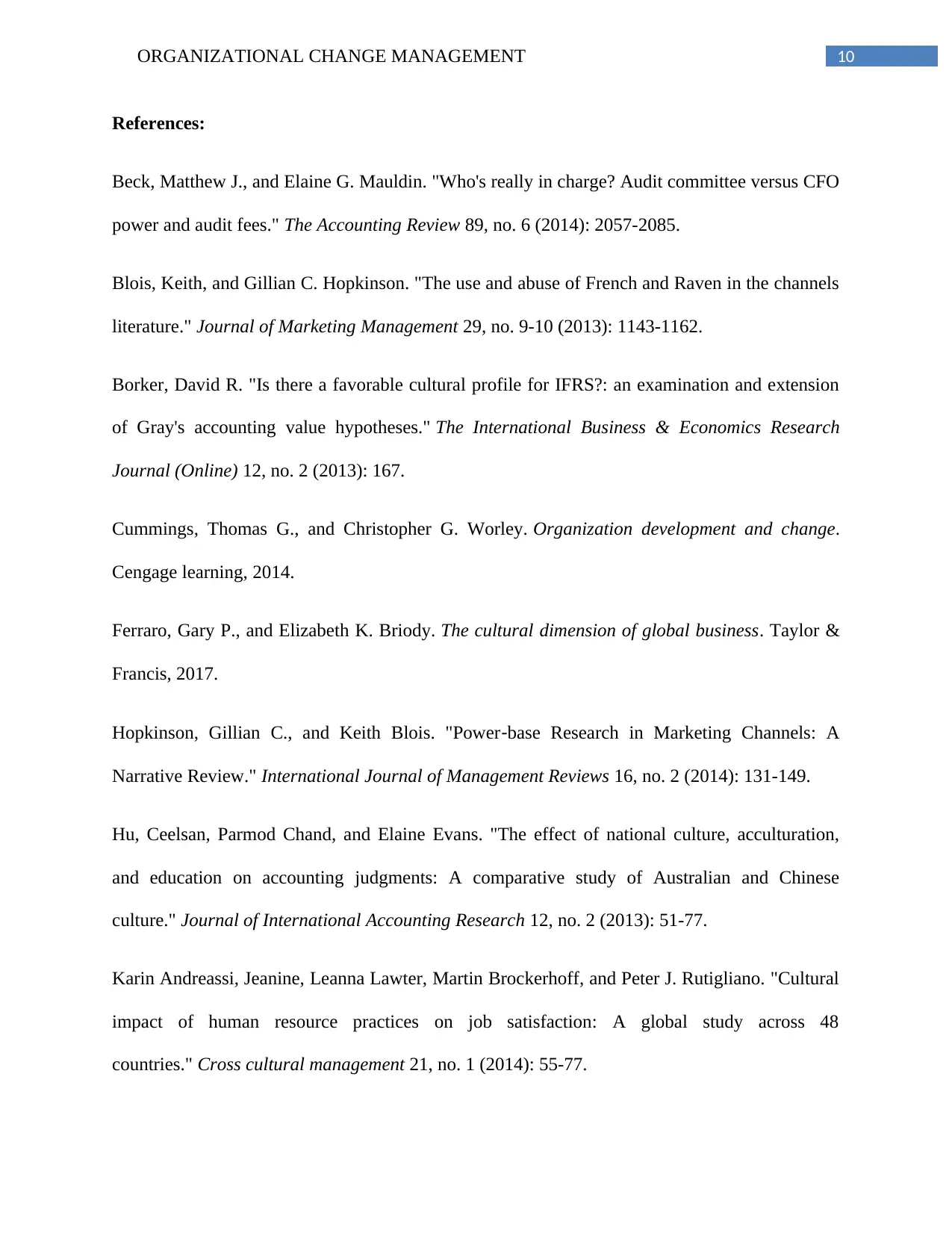
10ORGANIZATIONAL CHANGE MANAGEMENT
References:
Beck, Matthew J., and Elaine G. Mauldin. "Who's really in charge? Audit committee versus CFO
power and audit fees." The Accounting Review 89, no. 6 (2014): 2057-2085.
Blois, Keith, and Gillian C. Hopkinson. "The use and abuse of French and Raven in the channels
literature." Journal of Marketing Management 29, no. 9-10 (2013): 1143-1162.
Borker, David R. "Is there a favorable cultural profile for IFRS?: an examination and extension
of Gray's accounting value hypotheses." The International Business & Economics Research
Journal (Online) 12, no. 2 (2013): 167.
Cummings, Thomas G., and Christopher G. Worley. Organization development and change.
Cengage learning, 2014.
Ferraro, Gary P., and Elizabeth K. Briody. The cultural dimension of global business. Taylor &
Francis, 2017.
Hopkinson, Gillian C., and Keith Blois. "Power‐base Research in Marketing Channels: A
Narrative Review." International Journal of Management Reviews 16, no. 2 (2014): 131-149.
Hu, Ceelsan, Parmod Chand, and Elaine Evans. "The effect of national culture, acculturation,
and education on accounting judgments: A comparative study of Australian and Chinese
culture." Journal of International Accounting Research 12, no. 2 (2013): 51-77.
Karin Andreassi, Jeanine, Leanna Lawter, Martin Brockerhoff, and Peter J. Rutigliano. "Cultural
impact of human resource practices on job satisfaction: A global study across 48
countries." Cross cultural management 21, no. 1 (2014): 55-77.
References:
Beck, Matthew J., and Elaine G. Mauldin. "Who's really in charge? Audit committee versus CFO
power and audit fees." The Accounting Review 89, no. 6 (2014): 2057-2085.
Blois, Keith, and Gillian C. Hopkinson. "The use and abuse of French and Raven in the channels
literature." Journal of Marketing Management 29, no. 9-10 (2013): 1143-1162.
Borker, David R. "Is there a favorable cultural profile for IFRS?: an examination and extension
of Gray's accounting value hypotheses." The International Business & Economics Research
Journal (Online) 12, no. 2 (2013): 167.
Cummings, Thomas G., and Christopher G. Worley. Organization development and change.
Cengage learning, 2014.
Ferraro, Gary P., and Elizabeth K. Briody. The cultural dimension of global business. Taylor &
Francis, 2017.
Hopkinson, Gillian C., and Keith Blois. "Power‐base Research in Marketing Channels: A
Narrative Review." International Journal of Management Reviews 16, no. 2 (2014): 131-149.
Hu, Ceelsan, Parmod Chand, and Elaine Evans. "The effect of national culture, acculturation,
and education on accounting judgments: A comparative study of Australian and Chinese
culture." Journal of International Accounting Research 12, no. 2 (2013): 51-77.
Karin Andreassi, Jeanine, Leanna Lawter, Martin Brockerhoff, and Peter J. Rutigliano. "Cultural
impact of human resource practices on job satisfaction: A global study across 48
countries." Cross cultural management 21, no. 1 (2014): 55-77.
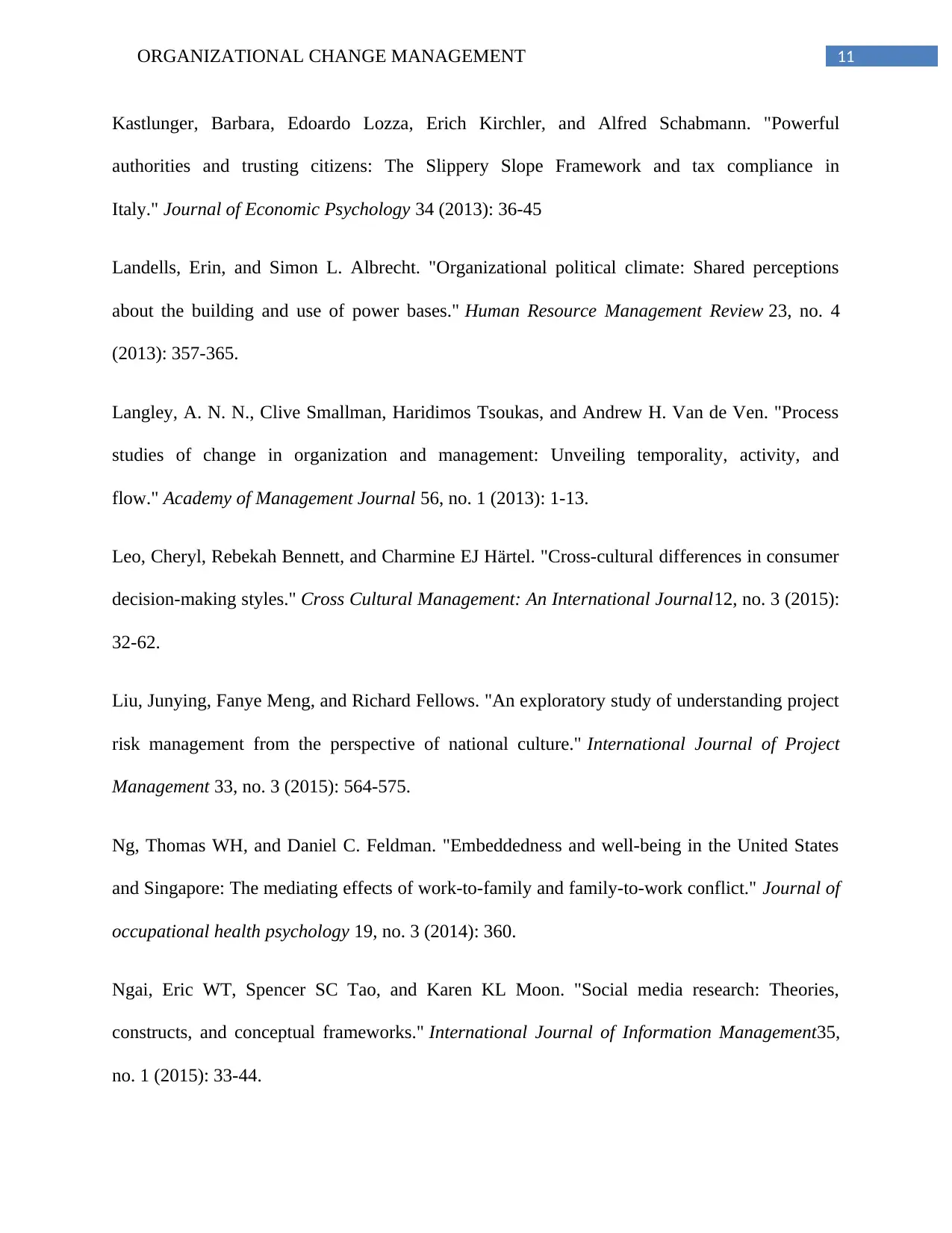
11ORGANIZATIONAL CHANGE MANAGEMENT
Kastlunger, Barbara, Edoardo Lozza, Erich Kirchler, and Alfred Schabmann. "Powerful
authorities and trusting citizens: The Slippery Slope Framework and tax compliance in
Italy." Journal of Economic Psychology 34 (2013): 36-45
Landells, Erin, and Simon L. Albrecht. "Organizational political climate: Shared perceptions
about the building and use of power bases." Human Resource Management Review 23, no. 4
(2013): 357-365.
Langley, A. N. N., Clive Smallman, Haridimos Tsoukas, and Andrew H. Van de Ven. "Process
studies of change in organization and management: Unveiling temporality, activity, and
flow." Academy of Management Journal 56, no. 1 (2013): 1-13.
Leo, Cheryl, Rebekah Bennett, and Charmine EJ Härtel. "Cross-cultural differences in consumer
decision-making styles." Cross Cultural Management: An International Journal12, no. 3 (2015):
32-62.
Liu, Junying, Fanye Meng, and Richard Fellows. "An exploratory study of understanding project
risk management from the perspective of national culture." International Journal of Project
Management 33, no. 3 (2015): 564-575.
Ng, Thomas WH, and Daniel C. Feldman. "Embeddedness and well-being in the United States
and Singapore: The mediating effects of work-to-family and family-to-work conflict." Journal of
occupational health psychology 19, no. 3 (2014): 360.
Ngai, Eric WT, Spencer SC Tao, and Karen KL Moon. "Social media research: Theories,
constructs, and conceptual frameworks." International Journal of Information Management35,
no. 1 (2015): 33-44.
Kastlunger, Barbara, Edoardo Lozza, Erich Kirchler, and Alfred Schabmann. "Powerful
authorities and trusting citizens: The Slippery Slope Framework and tax compliance in
Italy." Journal of Economic Psychology 34 (2013): 36-45
Landells, Erin, and Simon L. Albrecht. "Organizational political climate: Shared perceptions
about the building and use of power bases." Human Resource Management Review 23, no. 4
(2013): 357-365.
Langley, A. N. N., Clive Smallman, Haridimos Tsoukas, and Andrew H. Van de Ven. "Process
studies of change in organization and management: Unveiling temporality, activity, and
flow." Academy of Management Journal 56, no. 1 (2013): 1-13.
Leo, Cheryl, Rebekah Bennett, and Charmine EJ Härtel. "Cross-cultural differences in consumer
decision-making styles." Cross Cultural Management: An International Journal12, no. 3 (2015):
32-62.
Liu, Junying, Fanye Meng, and Richard Fellows. "An exploratory study of understanding project
risk management from the perspective of national culture." International Journal of Project
Management 33, no. 3 (2015): 564-575.
Ng, Thomas WH, and Daniel C. Feldman. "Embeddedness and well-being in the United States
and Singapore: The mediating effects of work-to-family and family-to-work conflict." Journal of
occupational health psychology 19, no. 3 (2014): 360.
Ngai, Eric WT, Spencer SC Tao, and Karen KL Moon. "Social media research: Theories,
constructs, and conceptual frameworks." International Journal of Information Management35,
no. 1 (2015): 33-44.
⊘ This is a preview!⊘
Do you want full access?
Subscribe today to unlock all pages.

Trusted by 1+ million students worldwide
1 out of 13
Related Documents
Your All-in-One AI-Powered Toolkit for Academic Success.
+13062052269
info@desklib.com
Available 24*7 on WhatsApp / Email
![[object Object]](/_next/static/media/star-bottom.7253800d.svg)
Unlock your academic potential
Copyright © 2020–2025 A2Z Services. All Rights Reserved. Developed and managed by ZUCOL.





